According to the Washington Post, China consumed more cement between 2011 and 2013 than United States used in the entire 20th century.
These figures shocked Bill Gates, the founder of Microsoft. Are these figures true? If so, how did China do it? China's economy is growing rapidly and its population is four times that of the United States. But America's heyday of expansion was the 20th century, when it built most of the nation's roads and bridges, the interstate highway system, the Hoover Dam, and many of the world's tallest skyscrapers. In terms of geographical area, China and the United States rank third and fourth in the world, respectively.
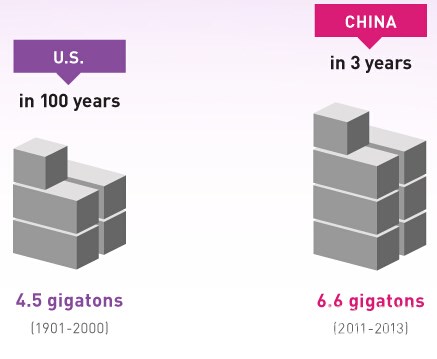
China used 6.6 billion tons of cement from 2011 to 2013, and the United States used 4.5 billion tons of cement in 100 years. (Source: Bill Gates blog)
The data may seem hard to believe, but according to official and industry sources, it seems to be accurate. In addition, if these data are carefully analyzed, it is surprising to find some reasonable explanations for the differences between the two countries and to see some ominous omens about China.
The data cited by Bill Gates comes from historian Vaclav Smil, who called cement "the most important material for the masses in the course of human civilization". He came up with the figures based on information from the United States Geological Survey. Data from the United States Geological Survey on the use of cement in the United States during the 20th century are as follows:
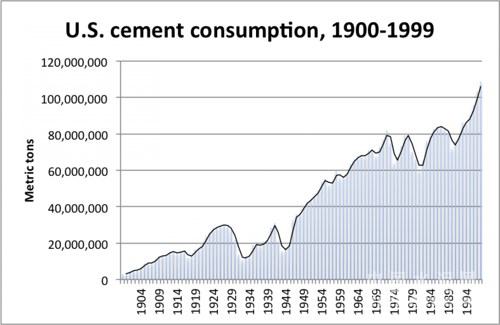
Cement consumption in the United States from 1900 to 1999
The table above shows some interesting economic trends — including the decline of the construction industry during the Great Depression, World War II, and the recession of the early 1980s. Cement consumption in the United States added up to 4.4 billion tons throughout the 20th century.
By comparison, China used about 6.4 billion tons of cement in the three years from 2011 to 2013, as shown in the following table from the International Cement Review, a UK-based industry publication. The USGS estimates similar for China's cement consumption: China consumed 1.4 times as much cement in the 2010-2012 period as the U.S. did in the 1900-1999 period, according to Hendrik Van Oss, a mineral commodities specialist at the USGS, the Hendrik van Oss.
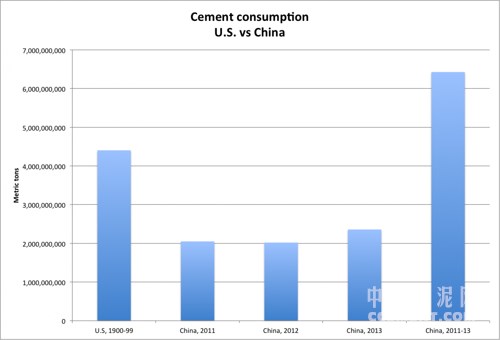
Comparison of cement consumption between China and the United States
Clearly, China has been consuming so much cement in recent years that if it were built into a cube, it could overlook Chicago; if it were built into a parking lot, it could cover Hawaii.
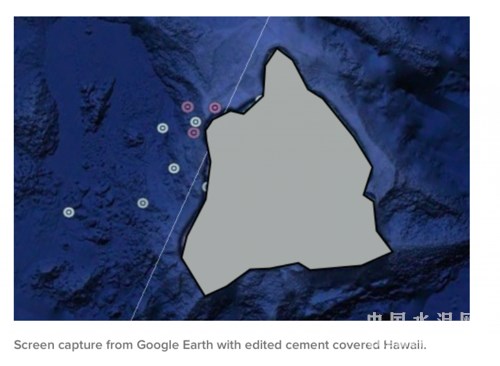
China consumes enough cement to cover Hawaii
So how does China use so much cement? First, rural areas are urbanizing at an unprecedented rate, far faster than United States did in the 20th century. Every year, more than 20 million Chinese move to cities, more than combined population of New York, Los Angeles and Chicago. This great change has taken place in the past 50 years. In 1978, less than one fifth of China's population lived in cities, and by 2020, the proportion will rise to 60%.
China's cities have been transformed to accommodate the influx of people. An estimated half of China's infrastructure was built in 2000, including new rail networks, provincial highways, dams, airports and skyscrapers springing up across the country. The following GIFs show the changes in Shanghai's Pudong district between 1987 and 2013, so you can see why Spike Jonze chose Pudong as the setting for the future city in his new film Her.
Compared with the changes in Shanghai, the development of the Pearl River Delta is even more shocking. The Pearl River Delta, a densely populated mainland region opposite Hong Kong, is a manufacturing hub with 42 million residents in 2010, according to the World Bank. If you look at the Pearl River Delta as a separate city-and you can say that, because the boundaries of the Pearl River Delta are already blurred-then it is the largest and most populous city in the world.
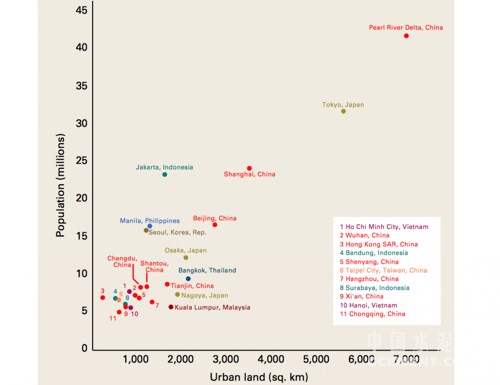
Regional population distribution by city
In addition to these "largest" cities in China, the number of "small" cities whose names are unknown is huge and even more unforgettable. In 2009, China had 221 cities with a population of one million, while Europe had only 35 in the same period. Relatively small cities like Zhengzhou and Jinan also have larger populations than Los Angeles and Chicago.
In addition to China's astonishing urbanization process, there are also some facts that are also important factors in the consumption of cement. As Goldman Sachs points out, although China's current population is only four times that of the United States, it is 15 times that of the United States in the early 20th century and five times that of the United States in 1950.
In addition, in the 20th century, there have been some changes in building materials in the world. In 1950, global steel production was equivalent to cement production, and by 2010, steel production had increased by about eight times, while cement production had increased by 25 times. Many houses in the United States are made of trees, but China is relatively short of wood. Unlike the United States, many Chinese people live in tall or low buildings made of cement.
In the end, China actually produced far more cement than it should have. Many of China's cement plants are state-owned, which allows them to enjoy government support and access to cheap capital. Like other state-owned industries with excess capacity – aluminum, steel, and shipbuilding – China's cement manufacturing has gone through a period of over-expansion without regard to product quality and profitability.
The huge cement industry has also brought great damage to the environment. Scientists estimate that the global cement industry is responsible for about 5% of the world's carbon emissions, and that about half of that cement comes from China.
In addition, due to low construction quality standards, concrete buildings in China are facing demolition and reconstruction in as little as 20-30 years. According to Goldman Sachs, about one-third of the cement used in China is a low-quality product that cannot be used in other countries.
When Bill Gates wrote about China's incredible consumption of cement on his blog, he said the material is important for helping the world's poorest people improve their quality of life. China's construction boom has spurred economic growth and lifted millions of people out of poverty.
However, China's huge consumption of cement also reveals some drawbacks in its economic sector. Too much top-down economic planning leads to waste of resources and huge environmental costs in the process of development. China's cement consumption is indeed impressive, but this may lay the foundation for future negative news.
Related topic reading:
Thoughts of Bill Gates, the Richest Man in the World, on China's Cement Industry



 浙公网安备33010802003254号
浙公网安备33010802003254号